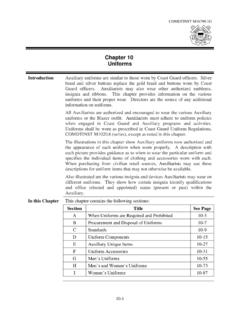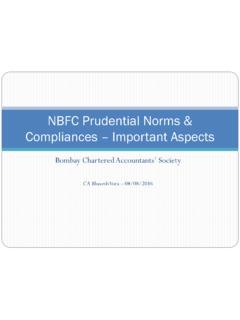Transcription of Part I Section 351.–Transfer to Corporation …
1 Part I Section 351. transfer to Corporation Controlled by Transferor 26 CFR : transfer to Corporation controlled by transferor. Rev. Rul. 2003-51 ISSUE Whether a transfer of assets to a Corporation (the first Corporation ) in exchange for an amount of stock in the first Corporation constituting control satisfies the control requirement of 351 of the Internal Revenue Code if, pursuant to a binding agreement entered into by the transferor with a third party prior to the exchange, the transferor transfers the stock of the first Corporation to another Corporation (the second Corporation ) simultaneously with the transfer of assets by the third party to the second Corporation , and immediately thereafter, the transferor and the third party are in control of the second Corporation .
2 FACTS Corporation W, a domestic Corporation , engages in businesses A, B, and C. The fair market values of businesses A, B, and C are $40x, $30x, and $30x, respectively. X, a domestic Corporation unrelated to W, also engages in business A through its wholly owned domestic subsidiary, Y. The fair market value of X s Y stock is $30x. W and X desire to consolidate their business A operations within a new Corporation in a holding company structure. Pursuant to a prearranged binding agreement with X, W forms a domestic Corporation , Z, by transferring all of its business A assets to Z in exchange for all of the stock of Z (the first transfer ).
3 Immediately thereafter, W contributes all of its Z stock to Y in exchange for stock of Y (the second transfer ). Simultaneous with the second transfer , X contributes $30x to Y to meet the capital needs of business A after the restructuring in exchange for additional stock of Y (the third transfer ). After the second and third transfers, Y transfers the $30x and its business A assets to Z (the fourth transfer ). After the second and third transfers, W and X own 40 percent and 60 percent, respectively, of the outstanding stock of Y. Viewed separately, each of the first transfer , the combined second and third transfers, and fourth transfer qualifies as a transfer described in 351.
4 LAW Section 351(a) provides that no gain or loss shall be recognized if property is transferred to a Corporation by one or more persons solely in exchange for stock in such Corporation and immediately after the exchange such person or persons are in control (as defined in 368(c)) of the Corporation . 2 Section 368(c) defines control to mean the ownership of stock possessing at least 80 percent of the total combined voting power of all classes of stock entitled to vote and at least 80 percent of the total number of shares of all other classes of stock of the Corporation . Section (a)(1) of the Income Tax Regulations provides that the phrase immediately after the exchange does not necessarily require simultaneous exchanges by two or more persons, but comprehends a situation where the rights of the parties have been previously defined and the execution of the agreement proceeds with an expedition consistent with orderly procedure.
5 Courts have held that the control requirement of 351 is not satisfied where, pursuant to a binding agreement entered into by the transferor prior to the transfer of property to the Corporation in exchange for stock, the transferor loses control of the Corporation by a taxable sale of all or part of that stock to a third party who does not also transfer property to the Corporation in exchange for stock. See, , S. Klein on the Square, Inc. v. Commissioner, 188 127 (2d Cir.), cert. denied, 342 824 (1951); Hazeltine Corp. v. Commissioner, 89 513 (3d Cir. 1937); Intermountain Lumber Co. v. Commissioner, 65 1025 (1976). The Service has reached the same conclusion when addressing similar facts.
6 See Rev. Rul. 79-194, 1979-1 145; Rev. Rul. 79-70, 1979-1 144; Rev. Rul. 70-522, 1970-2 81. In Rev. Rul. 70-140, 1970-1 73, A, an individual, owns all of the stock of Corporation X and operates a business similar to that of X through a sole proprietorship. Pursuant to an agreement between A and Y, an unrelated, widely held Corporation , A transfers all of the assets of the sole proprietorship to X in exchange for additional shares of X stock. A then transfers all his X stock to Y solely in exchange for voting common stock of Y. The ruling reasons that because the two steps of the transaction are parts of a prearranged plan, they may not be considered independently of each other for Federal income tax purposes.
7 The ruling concludes that A s receipt of the X stock in exchange for the sole proprietorship assets is transitory and without substance for tax purposes because it is apparent that the assets of the sole proprietorship are transferred to X to enable Y to acquire those assets without the recognition of gain to A. Accordingly, the ruling treats A as transferring its sole proprietorship assets directly to Y in a transfer to which 351 does not apply, and Y as transferring these assets to X, independently of A's transfer of the X stock to Y in exchange for Y voting stock. The exchange by A of the stock of X solely for voting stock of Y constitutes an exchange to which 354 applies.
8 See also (b)(3), Example 9. In Rev. Rul. 77-449, 1977-2 110, amplified by Rev. Rul. 83-34, 1983-1 79, and Rev. Rul. 83-156, 1983-2 66, a Corporation transfers assets to a wholly owned subsidiary, which in turn transfers, as part of the same plan, the same assets to its own wholly owned subsidiary. The ruling states that the transfers should be viewed separately for purposes of 351. Because each transfer satisfies the requirements of 351, no gain or loss is recognized by the transferor. 3 In Rev. Rul. 83-34, Corporation P owns 80 percent of the stock of a subsidiary, S1. An unrelated Corporation owns the remaining 20 percent.
9 P transfers assets to S1 solely in exchange for additional shares of S1 stock. As part of the same plan, S1 transfers the same assets to S2, a newly formed Corporation of which S1 will be an 80 percent shareholder. An unrelated Corporation will own the remaining 20 percent of the S2 stock. Citing Rev. Rul. 77-449, the ruling concludes that the transfers should be viewed separately for purposes of 351 and that each transfer satisfies the requirements of 351. In Rev. Rul. 84-111, 1984-2 88, Situation 1, a partnership transfers all of its assets to a newly formed Corporation in exchange for all the outstanding stock of the Corporation and the assumption by the Corporation of the partnership s liabilities.
10 The partnership then terminates by distributing all the stock of the Corporation to the partners in proportion to their partnership interests. The steps undertaken by the partnership were parts of a plan to transfer the partnership operations to a Corporation organized for valid business reasons in exchange for its stock and were not devices to avoid or evade recognition of gain. The ruling concludes that, under 351, the partnership recognizes no gain or loss on the transfer of its assets to the Corporation in exchange for the Corporation s stock and the Corporation s assumption of the partnership s liabilities, notwithstanding the partnership s subsequent distribution of the Corporation s stock to the partners and consequent loss of control within the meaning of 368(c) of the Corporation .

















